Sailing the Belize Barrier Reef
The morning was damp. The occasional sprinkle fell to challenge our merry mood. Despite the weather’s best efforts we could sense that the storm had blown itself out and was able to but threaten more rain, clouds and wind. The cold front had claimed its three windswept days and now the cycle began anew with sun breaking through the clouds on the horizon with rays of golden light.
The trip I’d booked was the three-day two night Raggamuffin Sailing trip from Caye Caulker, down through the Cayes and along the 2nd largest barrier reef in the world to the small peninsula town of Placencia. We left on Tuesday and would arrive on the 24th – Christmas eve. The all-inclusive trip cost $350 – which included a $50 premium for travel over the holidays/Christmas.
We loaded our bags then slowly piled onto the small motorboat that would shuttle us out to the still small, albeit slightly larger sailboat which would be our home for the next 3 days – the Ragga Queen.
With an old battered pirate flag flying, we set sail and with our backs to Caye Caulker began a new adventure. As we sailed south the sun slowly began to break through the clouds. Bringing with it a warmth that left us all pinching ourselves – trying to remember that it was currently late December. With a grin and a shrug we stripped down to swimsuits and lathered on sunscreen.
The sailing was easy and the three-man crew took care of most of the work. We’d help periodically as they raised sail or made small adjustments, but beyond that we were mostly left to our own devices. We mixed, mingled and got acquainted with each other. Told stories, played card games, napped, read and fished from the stern of the ship. Before long we noticed an odd structure – seemingly rising out of the water. The fishing shack which during low tide sat on an exposed sandbar rested on pillars: sandbar completely submerged. The small structure was fascinating. Not because of its complexity, but rather the fact someone had not only managed, but also decided, to build a structure literally in the middle of the ocean. In many ways it reminded me of the structures built for the movie Waterworld, only far less complex and obviously still anchored in sand. The building itself though was an odd reminder that we were sailing in shallow water – a poignant reality I had learned several nights previous when the ferry I was riding on ran aground multiple times.
The fishing was decent, though slow going. The first day we caught two – a decent sized barracuda and what I believe was a Spanish Mackerel – both served as the foundation for a delicious dinner later that evening. Unfortunately, despite no small amount of time spent manning one of the two lines – I ended up skunked. Still the fishing itself was plenty rewarding, as I watched the barrier reef and various islands slowly slip by.
We paused several times during the first day – dropping anchor seemingly at random just off the reef. The water was typically between 8-25 feet deep and crystal clear. Eager to explore we pulled on our fins and snorkels, paused briefly at the side of the boat and then jumped. The water’s embrace was warm – a delightful contrast from what you’d expect which made the transition far easier than I’ve grown accustomed to in the Pacific, Atlantic and even northern Sea of Cortez.
It never ceases to amaze me how big a difference fins make when snorkeling. Truly, they’re more a necessity than anything. Recalling my childhood dreams of being a Marine Biographer I double checked my Flip Ultra Video camera and marveled once again at how well the $35 underwater case was working out. Then without thinking, snorkel in mouth, I turned my sights to the seafloor, only to quickly get a mouth full of water and a quick reminder: snorkels and ear to ear grins seldom make good bedfellows.

The reef was rich with life – while not as tame and prolifically populated as the Hol Chan marine reserve, the reef was still awash in life and color. With vibrant coral, giant sea fans and sprawling beds of light green sea grass the reef was an absolute delight. Make sure to take a few minutes and watch the video at the start of this post. I’m afraid that all I have is underwater video, no photos.
As I made my way carefully into the shallower water, I paid special attention to the currents and my fins. Careful, ever so careful, not to make any contact with the reef or plant life. It sounds easy enough, but given the ebb and pull of waves, long sweep of fins and 5-7 feet of water it quickly became a challenge. We took great care to stay horizontal in the shallower water – keeping our feet, and fins well away from the seafloor where they might potentially do damage that would take years – if not decades to heal.
We snorkeled for half an hour – or was it an hour? – before making our way back to the boat and relaxing as we quenched our hunger with ham sandwiches and fresh conch ceviche. Then, settled in for another brief sail before a series of quick pauses, this time in much deeper water, where those willing set out in search of conch for dinner. Unfortunately, most of us found the water too deep and the conch too hard to spot – still we searched, swam, and enjoyed as the captain and crew who had more free diving experience made to 20+ foot journey to the sea floor and back easily. Later, the captain an ex-fisherman mentioned that during his fishing days he would regularly make 90+ foot free dives.
As the sun began to race towards the horizon we reached our destination for the evening. A delightful, tiny speck of sand with a deep water dock for the sailboat, 7 palm trees, and a small one room hut for the island’s steward. With 15 passengers and 3 crew, our little boat was overloaded. There was ample sitting room during the day, if you didn’t mind getting a bit cozy, but not even the faintest chance of fitting us all at night.
Luckily the island had room (if just barely) for 7 tents. We paired up, unloaded the tents, gear and sleeping pads, then set to assembling our tents. Some teams did better than others, leaving a few to grumble, huff, and curse gently under their breath as we all struggled to figure out just how the slightly off-center, somewhat worn tents had been designed.
Hartmut – a gentleman from Germany, my tent-mate and a friend I’d bump into during later travels – and I quickly got our tent assembled and began to wander the island. Despite its small stature the island was absolutely gorgeous.
The island’s white sands were soft, warm in the afternoon’s fading sunlight, and a beautiful white that picked up the hues of the sunset and seemed to blend seamlessly with the lapping waves.
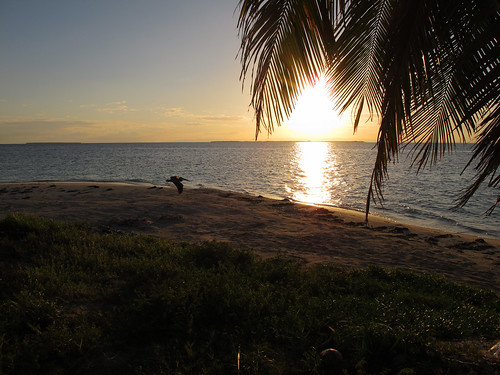
The locals themselves – mostly seagulls and pelicans – were also quite hospitable. Lazily sharing the island with us, and periodically taking flight to feed or just circle the island in an incredible show of grace.
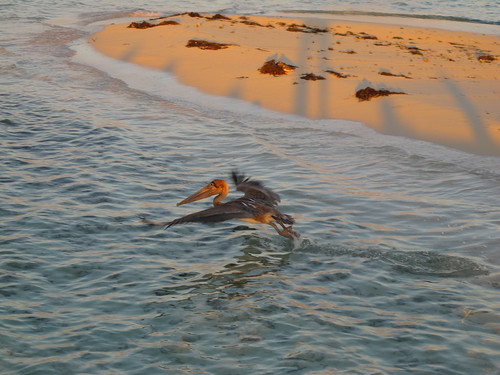
The pelicans themselves, while wary, seemed comfortable with visitors. More than that though, they seemed almost eager to show off their natural agility and skills.
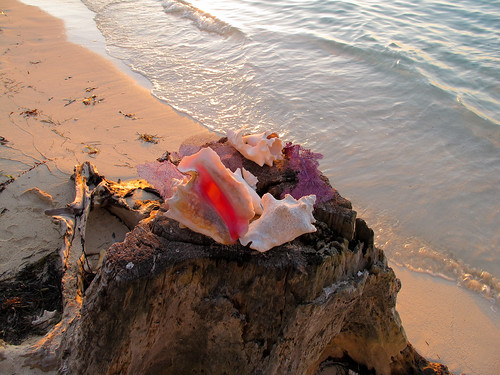
Antsy, I wandered a bit more – pausing at an old tree stump that now held a dried coral fan and several conch. As the sun set behind it – I held my breath in anticipation.
As we paused, enjoying our dinner of fresh seafood and garlic bread the sun continued to set. As each minute passed it revealed new beauty, new colors and my smile grew.
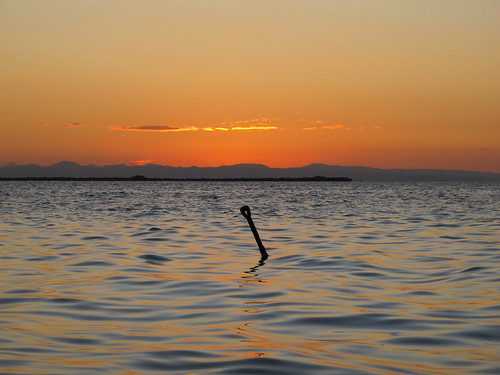
Words cannot describe the incredible beauty of the sunset as it set the sky afire. The leftover clouds – those straggling behind the cold front – picked up the sun’s evening song and magnified it ten fold. The waves of the ocean gently moaned as they slowly tickled the white sandy beaches – turned golden by the sunset.
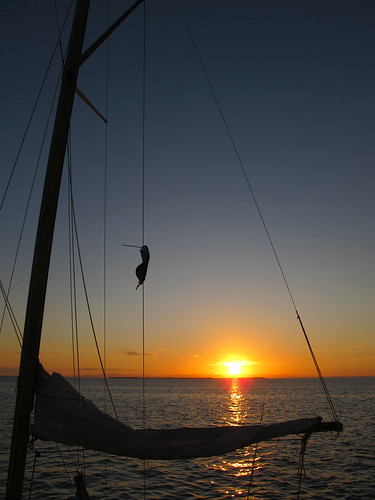
It had been a good day. An incredible one, that I’ll remember for the rest of my life – but as the sun set and we settled in around a campfire I quickly realized that the day held one last surprise. As complete darkness settled over our small island, with the fire slowly burning down – I sprawled lazily across the sand and looked up.
The stars were incredible – so vivid, so densely packed and so bright that I could hardly contain a soft sigh. Living in the city, the stars are always dim and far away. On the rare occasions I escape into the countryside camping or return back to my parent’s home in Prescott I can always count on vivid stars but even those barely compared to the sight that greeted me.
It was as though the galaxy itself sat just out of reach. The depth and richness of the stars something beyond the norm, something special, something incredible. Then breathing slowly, eyes roaming the sky I saw the first shooting star. Then another. Then a third, a fourth, a fifth…they blazed across the sky in incredible arks. As luck would have it – I was witnessing what I believe was the Ursid meteor shower. The view that night alone made the trip well worth it.
Stay tuned for part II of this post covering days 2 and 3. Can’t wait? Check out my Belize photo stream on flickr. Q9VRSZ4BCZXJ
Clear water snorkeling, vivid sunset and a meteor shower racing across the sky – what an adventure. Thanks for sharing, especially the video.
Thanks for reading and watching Donna!
Beautiful photographs I am extremely jealous.